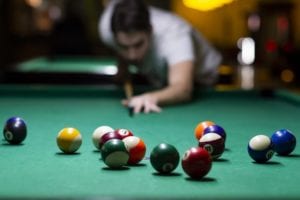
What is a bank shot?Â
Before we begin, let’s discuss the fundamentals of a bank shot. You may even be wondering what it is. Bank means to bounce a ball off the opposite rails of the pool table to make a shot. This can be done with the cue or object ball and is always taken at a strategic angle. A well-executed bank shot requires two elements: the force at which you shoot the ball and the path it takes. And while they may take a bit of practice, getting these down will significantly refine your billiards game.
Steps to a perfect bank shot:
- Number the diamonds along each rail. Beginning with the corner pocket, number each diamond one through five on the foot rail and one through nine on the long rail. While the exact number of diamonds may differ with varying sizes of pool table, a regulation-sized table will include this amount. Fewer diamonds, however, should make no difference in your bank shot performance. What’s important is knowing how to use the diamonds when determining your best shooting angle.
- Assign a number position for the cue and object ball. This is based on the diamond closest in proximity to each ball. And when a ball lands in between two diamonds, you can assign intermediate numbers such as ‘4.5.’
- Splitting the difference. Your goal in bank shots is first to find the halfway point between your cue and object balls. So to do this, subtract the diamond number of the cue ball from that of the object ball. Divide that number in two. For example, if your cue ball is at one and your object ball is at 4, you’ll get 4-1=3. So, your halfway point would be half of three, or one and a half diamond lengths.
- Aim for the diamond at your halfway point. In the example, you’ll shoot for the one and a half diamond point to achieve the perfect mirrored angle. Once you’ve determined your target and positioned your cue in a 45-degree angle, you’re ready to bank the object ball straight into the diamond and ideally into the pocket!
Keep in mind that speed plays a crucial factor in your backshots. The harder you hit the ball, the tighter the angle and the softer your hit, the wider the angle. Determining the halfway point, creating a 45-degree angle, and making the shot at an appropriate speed is far from easy. However, with sufficient practice, this bank shot will lend consistency and precision to your billiards game.While practice makes perfect, it’s only possible with a great table. So if you’re in the market for a pool table to call you own and for unlimited practice shots, call on us. We at Games for Fun are stocked with the right table for you and at a great price. Reach out today for billiard tables for every level as well as supplies for every other game you can imagine.


